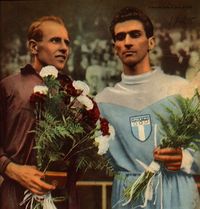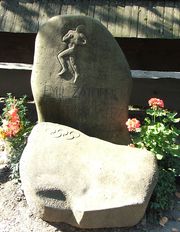Emil Zátopek
| Medal record | ||
Emil Zátopek |
||
| Men's athletics | ||
|---|---|---|
| Competitor for |
||
| Olympic Games | ||
| Gold | 1948 London | 10000 metres |
| Gold | 1952 Helsinki | 5000 metres |
| Gold | 1952 Helsinki | 10000 metres |
| Gold | 1952 Helsinki | Marathon |
| Silver | 1948 London | 5000 metres |
| Pierre de Coubertin medal | 2000 | |
| European Championships | ||
| Gold | 1950 Brussels | 5000 m |
| Gold | 1950 Brussels | 10000 m |
| Gold | 1954 Bern | 10000 m |
| Bronze | 1954 Bern | 5000 m |
Emil Zátopek (Czech pronunciation: [ˈɛmɪl ˈzaːtopɛk] (![]() listen)) (September 19, 1922 – November 22, 2000) was a Czech long-distance runner best known for winning three gold medals at the 1952 Summer Olympics in Helsinki. He won gold in the 5000 metres and 10,000 metres runs, but his final medal came when he decided at the last minute to compete in the first marathon of his life. He was nicknamed the "Czech Locomotive" for his multiple golds.
listen)) (September 19, 1922 – November 22, 2000) was a Czech long-distance runner best known for winning three gold medals at the 1952 Summer Olympics in Helsinki. He won gold in the 5000 metres and 10,000 metres runs, but his final medal came when he decided at the last minute to compete in the first marathon of his life. He was nicknamed the "Czech Locomotive" for his multiple golds.
Zátopek was the first athlete to break the 29-minute barrier in the 10 km run (in 1954). Three years earlier, in 1951, he had broken the hour for running 20 km. He is widely considered to be one of the greatest runners of the 20th century and was also known for his brutally tough training methods.
Contents |
Early years

Emil Zátopek was born in Kopřivnice, Czechoslovakia on September 19, 1922, as the sixth child of a modest family. When Zátopek was 16, he began working in a Bata[1] shoe factory in Zlín. Zátopek says that "One day, the factory sports coach, who was very strict, pointed at four boys, including me, and ordered us to run in a race. I protested that I was weak and not fit to run, but the coach sent me for a physical examination, and the doctor said that I was perfectly well. So I had to run, and when I got started, I felt I wanted to win. But I only came in second. That was the way it started."[2] Zátopek finished second out of the field of 100. After that point, he began to take a serious interest in running.
A mere four years later, in 1944, Emil broke the Czech records for 2,000, 3,000, and 5,000 meters. He was selected for the Czech national team for the 1946 European Championships and finished fifth in the 5K, breaking his own Czech record of 14:50.2, running 14:25.8.
Competitions
Zátopek first entered the international athletics field at the 1948 Summer Olympics in London, winning the 10 km (his second race at that distance) and finishing second behind Gaston Reiff from Belgium in the 5 km.
The following year Zátopek broke the 10 km world record twice, and went on to better his own record three times over the next four seasons. He also set records in the 5 km (1954), 20 km (twice in 1951), one-hour run (twice in 1951), 25 km (1952 and 1955), and 30 km (1952). He won the 5 km and 10 km at the 1950 European Championships and the 10 km at the next European Championships.
At the 1952 Summer Olympics in Helsinki Zátopek won gold in the 5 km run, 10 km run, and the marathon. He also broke the existing Olympic record in each of the three events. His victory in the 5 km came after a ferocious last lap in 57.5 seconds, during which he went from fourth place to first while Christopher Chataway, now second after being overtaken by Zátopek, tripped on the curb and fell. His final medal came when he decided at the last minute to compete in the marathon for the first time in his life, and won. His strategy for the marathon was simple: he raced alongside Jim Peters, the British world-record holder. After a punishing first fifteen kilometers in which Peters knew he had overtaxed himself, Zátopek asked the Englishman what he thought of the race thus far. The astonished Peters told the Czech that the pace was "too slow," in an attempt to slip up Zátopek, at which point Zátopek simply accelerated. Peters never finished; Zátopek ran an Olympic record race.
Zátopek attempted to defend his marathon gold medal in 1956; however, he suffered a groin injury while training and was hospitalized for six weeks. He resumed training the day after leaving the hospital and never quite regained his form, finishing sixth to his old rival and friend Alain Mimoun. He retired from competition in 1957.

Zátopek's running style was distinctive and very much at odds with what was considered to be an efficient style at the time. His head would often roll, face contorted with effort, while his torso swung from side to side. He often wheezed and panted audibly while running, which earned him the nicknames of "Emil the Terrible" or "the Czech Locomotive". When asked about his tortured facial expressions, Zátopek is said to have replied that "It isn't gymnastics or ice-skating, you know." In addition he would train in any weather, including snow, and would often do so while wearing heavy work boots as opposed to special running shoes. He was always willing to give advice to other runners. One example he often gave was to always be relaxed and to help ensure that while running, gently touch the tip of your thumb with the tip of your index or middle finger. Just making that slight contact would ensure that arms and shoulders remained relaxed.

Later years
A hero in his native country, Zátopek was an influential figure in the Communist Party. However, he supported the party's democratic wing, and after the Prague Spring, he was removed from all important positions and forced to work in a uranium mine as punishment. On the 9th of March 1990, Zátopek was rehabilitated by Václav Havel. Zátopek died in Prague, after a long illness, in 2000 at the age of 78. He was awarded the Pierre de Coubertin medal posthumously in December 2000.
Personal life
His wife Dana Zátopková (born the same day as her husband) was an outstanding athlete in her own right in the javelin throw. She won the gold medal in the javelin in the 1952 Summer Olympics - only a few moments after Emil´s victory in the 5 km run - and the silver medal in the 1960 Summer Olympics. An example of the playful relationship between husband and wife came when Emil attempted to take some credit for his wife's Olympic victory at her press conference, claiming that it was his victory in the 5 km run that had "inspired" her. Dana's indignant response was, "Really? Okay, go inspire some other girl and see if she throws a javelin fifty meters!!"
Emil and Dana were the witnesses at the wedding ceremony of Olympic gold medalists Olga Fikotová and Harold Connolly in Prague in 1957. Emil had spoken to the Czechoslovak president Antonín Zápotocký to request help in getting Olga a permit to marry Connolly. While it's not clear how much this helped, they surprisingly received a permit a few days later.[3]
Trivia
In 2008 a new Belgian magazine for runners called Zatopek was born. The authorization to use the name was granted by his widow Dana Zátopková. The first issues of the magazine publish a long interview with her.
Zatopek is the only Olympic athlete whose statue appears at the Musée Olympique in Lausanne.
References
External links
- Emil Zatopek at Running Times
- Emil Zátopek at Find a Grave
- Emil Zatopek Biography
- Running Past profile of Zatopek
- Archive Video of 5 km Olympic run from Runningpast.com
|
|||||
|
|||||
|
||||||||
|
|||||
|
|||||
|
|||||
| Records | ||
|---|---|---|
| Preceded by |
Men's 5000 m world record holder May 30, 1954 – August 29, 1954 |
Succeeded by |
| Preceded by |
Men's 10000 m world record holder June 11, 1949 – September 1, 1949 |
Succeeded by |
| Preceded by |
Men's 10000 m world record holder October 22, 1949 – July 15, 1956 |
Succeeded by |
| Preceded by |
Men's one hour run world record holder September 15, 1951 – August 24, 1963 |
Succeeded by |
| Preceded by |
Men's 20000 m world record holder September 15, 1951 – August 24, 1963 |
Succeeded by |
| Preceded by |
Men's 25000 m world record holder October 26, 1952 – September 27, 1955 |
Succeeded by |
| Preceded by |
Men's 25000 m world record holder October 29, 1955 – July 21, 1965 |
Succeeded by |
| Preceded by |
Men's 30000 m world record holder October 26, 1952 – October 21, 1956 |
Succeeded by |